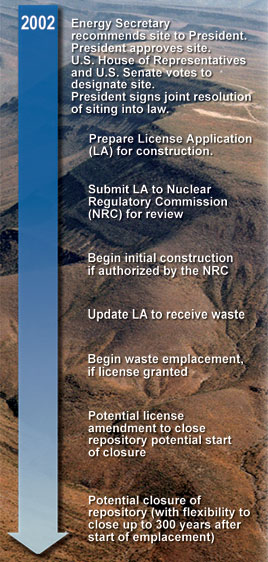
In July 2002, President Bush signed a bill designating the Yucca
Mountain site (located in Nye County, approximately 100 miles
northwest of Las Vegas, Nevada) for development as a repository for
the disposal of spent nuclear fuel and high-level radioactive waste.
The license application consists of a letter describing its purpose,
accompanied by attachments that contain general information and a
Safety Analysis Report (SAR).
The NRC is the licensing and enforcement agency that will make the
final decision on whether the DOE is allowed to proceed with
construction and subsequently licensed to operate the repository.
NRC approval consists of two steps:
The
license application consists of a letter describing
its purpose, accompanied by attachments that contain
general information and a safety analysis report.
-
The general information portion of the
application will provide an overview of the
repository’s engineering design concept and will
describe the natural features of the site.
-
The safety analysis report (the main technical
document in the licensing process) will
demonstrate how the repository can be
constructed, operated, and closed in a manner
that protects public and worker health and
safety and preserves the quality of the
environment.
After
the license application has been completed, DOE will
submit it to the NRC. The NRC will perform an
acceptance review to determine if the application is
suitable for performing a detailed technical review.
After the license application is docketed, the NRC
will conduct extensive technical reviews and legal
hearings during which it will consider the
scientific and design information on the repository.
As required by law, the hearings will be open to the
public.
A hearing panel appointed by the NRC, referred to as
the Atomic Safety and Licensing Board, will conduct
the licensing proceeding. After completion of the
proceeding, the board will forward its initial
decision to the commissioners for their review.
The NRC will grant a construction authorization only
if it concludes from its investigations that the
repository would meet its reasonable expectation
that the safety and health of workers and the public
would be protected.
After construction authorization is granted, DOE
will begin initial construction. The license
application and subsequent revisions to the
application, made in response to NRC requests for
additional information, would be updated to reflect
any new or more detailed information and submitted
to the NRC in support of receiving a license.
-
A
license application — which consists of general
information and a safety analysis report (SAR) —
is scheduled to be submitted to the NRC.
-
After the NRC completes its acceptance review of
the material contained in the general
information and SAR and determines the submittal
to be complete, it will announce in the
Federal Register an opportunity for
interested parties to participate in hearings.
The hearings will be presided over by an Atomic
Safety and Licensing Board. Multiple boards may
be appointed. Boards typically have three
members — an administrative law judge who is a
lawyer to run the proceeding and two technical
experts. Boards may have more than three
members.
-
Board members are drawn from a panel of
pre-approved, qualified members. Entities and
individuals interested in supporting or opposing
the repository will be required to file
petitions to be admitted as parties to the
proceeding, as well as file legally- or
technically-relevant contentions. The board may
permit limited appearances by those wishing to
make brief statements but not become parties.
-
At
the same time the board is performing its legal
functions, the NRC staff will conduct a
technical review of the general information and
SAR. As a result of that review, the NRC staff
will generate questions on the license
application, referred to as requests for
additional information, which DOE will answer in
the form of revisions to the general information
and SAR.
-
The Board will examine the proposed contentions
and rule on each. After the NRC staff completes
its technical review and the board completes
processing proposed contentions, the two efforts
will converge in the hearing process. DOE, NRC,
and (in some instances) contractor staff will
have to take the stand to address contentions
admitted by the board.
After all contentions and responses have been
heard by the board, the board will issue its
initial decision regarding construction. If the
decision is not overturned by the commissioners
or the appellate court, construction can begin.
From:
DOE Fact Sheet "Repository Licensing Process",
DOE/YMP-0111, September 2005

